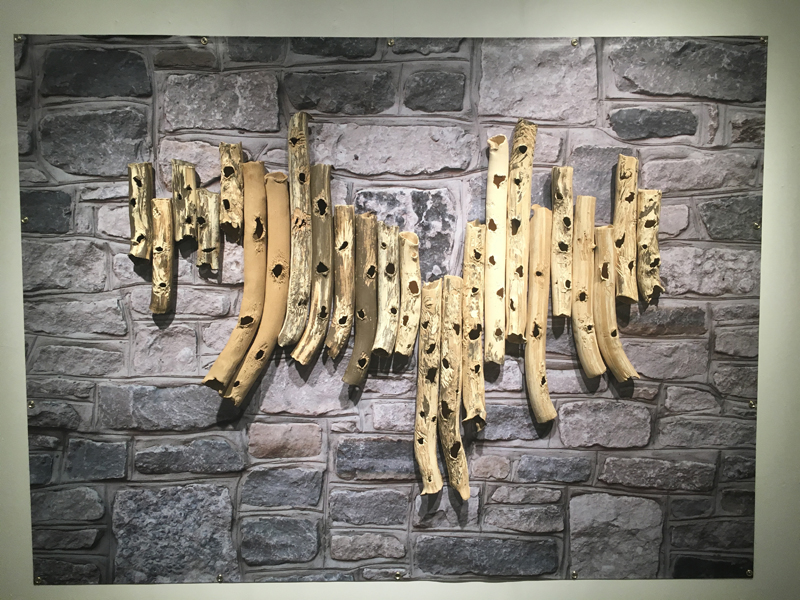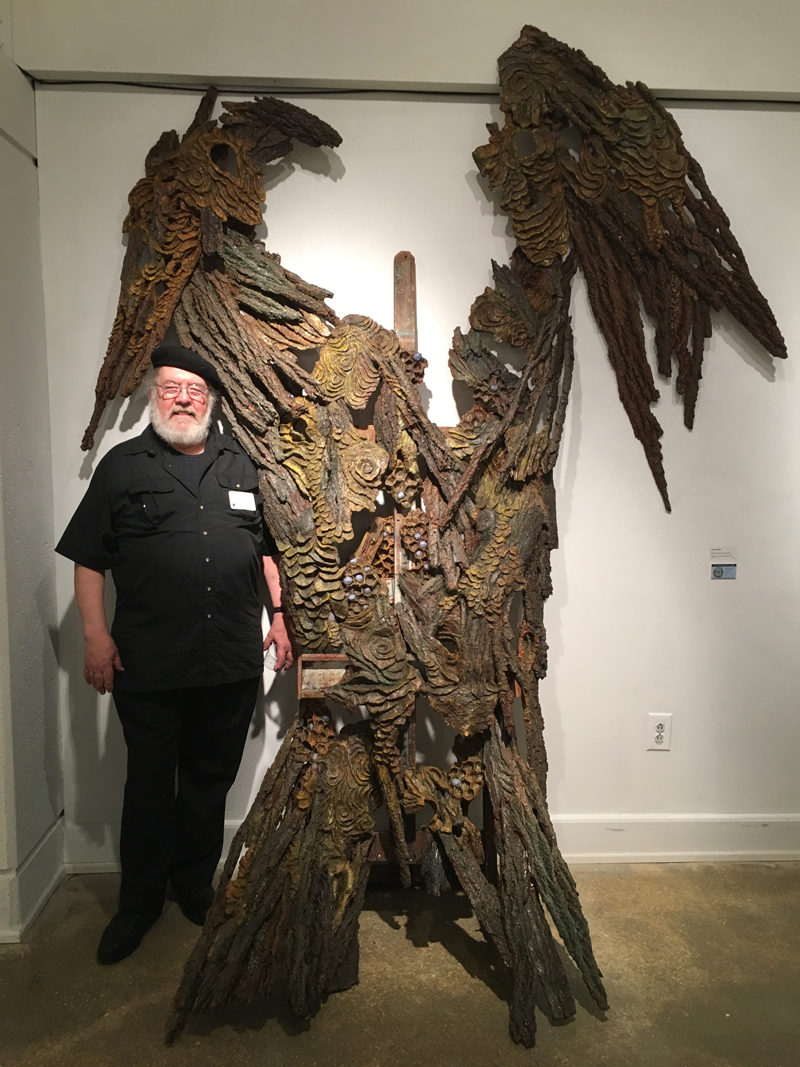Animal Architects: Influences on Human Creativity This Summer at the Monmouth Museum
Winged Hornet of Samothrace, 2017, Mixed Media, by Gyuri Hollosy
“I dream inside the shapes I make”
“As a sculptor and installation artist, I could relate to the animals’ collecting of materials, selecting a site and planning the building process,” said Donna Payton, curator and artist of Animal Architects: Influences on Human Creativity on display now in the Main Gallery of the Monmouth Museum through September 3, 2017. Through-out the summer there will be workshops by the artists in the Meyer Art & Nature Area of the Museum. Dates, and times can be found on the Museum’s website: monmouthmuseum.org.
Animal Architects: Influences on Human Creativity, features the artwork of Harry Bower, Dana Michele Hemes, Susan Hoenig, Gyuri Hollósy, Eve Ingalls, Joy Kreves, Eva Mantell, Donna Payton, Kathleen Hayden Preziosi, Libby Ramage, and Richard Sanders. These eleven artists have presented a variety of innovative two and three dimensional artworks in an eclectic mix of media to open our eyes to the amazing engineering feats that exist throughout the animal kingdom while highlighting the awe inspiring nature of human artistic creativity.
Payton was inspired by the “art” of animals, after reading the book Animal Architects, Building and the Evolution of Intelligence by James L. Gould and Carol Grant Gould. James is an ecologist and evolutionary biologist at Princeton University; Carol is a professional science writer. Payton seeks to bring animal homes to the attention of art lovers, as well as to encourage scientists to “start thinking about art a little,” she said, “to give a different dimension to their process and the way they think.” Like many compelling works of art, the pieces in Animal Architects challenge the viewer to experience the world from a new perspective. Imagine weaving twigs using a bird’s beak. Try doing it yourself with one hand. It may seem easy, but after a long while you may just have a pathetic pile of sticks. This one example illuminates the intelligence capabilities of species us humans would like to think of as inferior; the simplest structures of ants, birds, wasps and bees, show what levels of brain complexity are necessary for the construction of such structures.
Excited by the connection between artists and animals, Payton asked the ten artists to read the Goulds’ book for inspiration to create Animal Architects. The artists have used animal architects’ ingenuity for building and constructing as a reference. While not intended as a scientific replication of actual animals’ homes, the book served as the artist’s departure point and inspirational fodder. They have combined many of the same construction materials used by animals with traditional art materials and technology. Shapes and forms created by the original animal builders are explored and re-imagined by the artists. Similar to the animal architects, humans unconsciously employ specialized tactile mapping circuits to facilitate building structures. Although we differ motivationally in our creative efforts, ours being aesthetic and expressive and animals being survival and procreation, the end results are both structures of ingenuity and beauty.
Gyuri Hollósy’s Fugue in Hornet Mansion is visually striking, with frills and pockets, honeycomb and ball shapes, all fused together in an unusual shape, a good 8-feet tall and 6-feet wide. It calls to viewers from across the room and continues to fascinate up close, with peekaboo elements and colors that, appearing brown at first, resonate with sparkle, and break down into blues and rusts, yellow and gold. Fascinatingly, it is made of resin-bonded sawdust.

The World of the Organ Pipe Wasp, 2016, ceramic, photographic mural by Donna Payton
“I chose the nest designs first because it reflected my visual voice of the overlapping part connecting with other parts similar to the style in my work,” says Hollósy, who has taught at the Johnson Atelier Institute of Sculpture. “Later I determined its variety being that of the European Hornet which immigrated some time in the 1840s. The Bald Faced Hornet was also part of the consideration for pattern and color. They both use wood pulp to make their nests using saliva and water as a bonding agent to make their paper-thin nests. Since I’m also an immigrant from Europe and work with sawdust bonded with resin, I felt this concept was a perfect fit and a personal connection between the insect and myself.”
Joy Kreves’ work looks as if it emerged from a fairy world. Her understanding of how nature builds and her ability to replicate it, as well as playing on it with her humor, are hallmarks of a gifted artist.
Susan Hoenig a painter and ecological sculptor, is fascinated by the patterns made by leaf miners on leaves. “For many years I have been collecting leaves and discovered a phenomena that I find truly fascinating,” she says. “The leaves are the dwellings of animals, various insects’ architectural habitat.” Leaf miners are larvae that dwell in the layer between the leaf’s upper and lower epidermis. The pattern on the leaf is from the serpentine tunnels that leaf miner’s make as they eat their way through. Different miners make different, distinctive kinds of tunnels. The miners emerge as adults within the leaf and pupate in the soil below. Hoenig says “I paint these dwelling of insect larvae, for they are an important part of our eco-system.”
One chapter of the Gould’s book is devoted to the structures built by male bowerbirds, which are among the most extreme examples of sexual selection. Although made of twigs and other found objects, bowers are not nests; they are more accurately described as “sex sculptures,” according to James Gould. With great variation among species, male bowerbirds build fancy huts, “maypoles,” and “avenues” to entice female mates.
Sculptor Harry Bower was intrigued by the birds’ craftsmanship. Aside from the connection to his own name, said Bower, “I’m a fiber artist, so I could relate to any of the animals or insects that did any kind of spinning, wrapping, or weaving.” This summer through his workshops held at the Monmouth Museum, he will assist in creating a community art project in the Museum’s Meyer Art & Nature Area, and invite the students to create embellishments for an existing “Bower Bird Structure.” The workshop will include discussion about the bowerbird and its creations. The workshop for younger ages will be working with pre-made triangular structures and found objects provided by the instructor. Adults will work with similar materials, creating their own structures with branches and bamboo.
Eva Mantell since learning about animal architecture said “I have become more aware of the engineering feats of creatures around myself. The more I learn about animal architecture the more I think the webs, traps, nests, storerooms, bedrooms and bathrooms that animals create ought to be winning architecture awards.”
In curating this traveling exhibition, Animal Architects: Influences on Human Creativity’s Donna Payton selected artists who had an organic approach and fondness for a variety of materials. They are adventuresome builders interested in the forms animals build. Included are a selection of artistic disciplines – weaver, ceramicist, painters and sculptors. This exhibition elicits one wow after another!
The Monmouth Museum has teamed up with LizenUp to bring the latest in Audio Guide technology for this exhibition. While at the Museum, using this app, you may listen to the stories of the pieces that you find interesting in the exhibition. Learn what inspired the artist and how the piece was created.
Museum Summer Workshops that will be offered by the artists for adults and children are:
July 13th from 11:00am – 12:00pm artist Libby Ramage will present a children’s workshop for ages 5-7 and from 1:00pm-3:00pm for ages 8 and older on Animal Windsocks.
July 19th from 1:00pm-3:00pm artist Eva Mantell will present a children’s workshop for ages 5 and up, great for families, Bower Bird Challenge.
July 26th from 1:00pm-3:00pm artist Harry Bower will present the Build Like a Bowerbird workshop for ages 8 and over.
August 8th from 10:30am-12:30pm artist Harry Bower will present the Build Like a Bowerbird workshop for Teens-Adults.
August 31st from 1:00pm-3:00pm artist Susan Hoenig will present a Leaf, Watercolor and Pastels workshop for ages 8 to adult.
The cost is $10.00 to participate in the artist’s workshops.
Admission to the Museum and exhibition is $8, Members are Free. The Museum is located on 765 Newman Springs Road, Lincroft, NJ, Parking Lot #1 on the campus of Brookdale Community College.
The Monmouth Museum, a private, non-profit organization was founded in 1963 as a Museum of Ideas, presents changing art, history and science exhibitions to educate and entertain while providing a destination for creative expression and life-long learning to the diverse community it serves.
For more information about the Monmouth Museum exhibits and programs their website is www.monmouthmuseum.org or call 732-747-2266. You can also find them on Facebook, Twitter, Instagram, and Pinterest.



